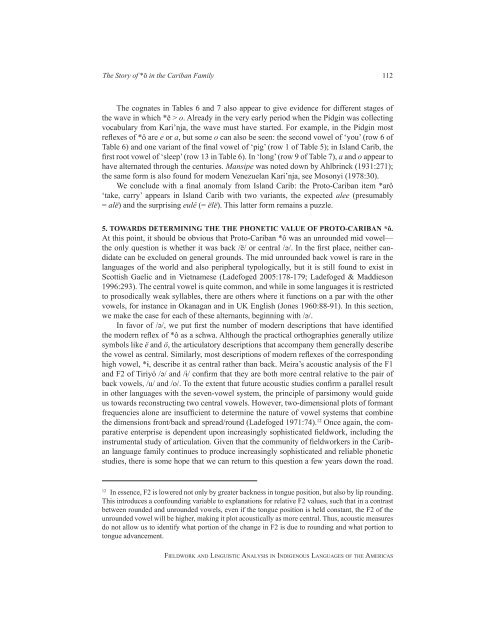Fieldwork and Linguistic Analysis in Indigenous ... - ScholarSpace
Fieldwork and Linguistic Analysis in Indigenous ... - ScholarSpace
Fieldwork and Linguistic Analysis in Indigenous ... - ScholarSpace
You also want an ePaper? Increase the reach of your titles
YUMPU automatically turns print PDFs into web optimized ePapers that Google loves.
The Story of *ȏ <strong>in</strong> the Cariban Family 112<br />
The cognates <strong>in</strong> Tables 6 <strong>and</strong> 7 also appear to give evidence for different stages of<br />
the wave <strong>in</strong> which *ë > o. Already <strong>in</strong> the very early period when the Pidg<strong>in</strong> was collect<strong>in</strong>g<br />
vocabulary from Kari’nja, the wave must have started. For example, <strong>in</strong> the Pidg<strong>in</strong> most<br />
reflexes of *ô are e or a, but some o can also be seen: the second vowel of ‘you’ (row 6 of<br />
Table 6) <strong>and</strong> one variant of the f<strong>in</strong>al vowel of ‘pig’ (row 1 of Table 5); <strong>in</strong> Isl<strong>and</strong> Carib, the<br />
first root vowel of ‘sleep’ (row 13 <strong>in</strong> Table 6). In ‘long’ (row 9 of Table 7), a <strong>and</strong> o appear to<br />
have alternated through the centuries. Mansipe was noted down by Ahlbr<strong>in</strong>ck (1931:271);<br />
the same form is also found for modern Venezuelan Kari’nja, see Mosonyi (1978:30).<br />
We conclude with a f<strong>in</strong>al anomaly from Isl<strong>and</strong> Carib: the Proto-Cariban item *arô<br />
‘take, carry’ appears <strong>in</strong> Isl<strong>and</strong> Carib with two variants, the expected alee (presumably<br />
= alë) <strong>and</strong> the surpris<strong>in</strong>g eulê (= ëlë). This latter form rema<strong>in</strong>s a puzzle.<br />
5. TOWARDS DETERMINING THE THE PHONETIC VALUE OF PROTO-CARIBAN *ô.<br />
At this po<strong>in</strong>t, it should be obvious that Proto-Cariban *ô was an unrounded mid vowel—<br />
the only question is whether it was back /ë/ or central /ə/. In the first place, neither c<strong>and</strong>idate<br />
can be excluded on general grounds. The mid unrounded back vowel is rare <strong>in</strong> the<br />
languages of the world <strong>and</strong> also peripheral typologically, but it is still found to exist <strong>in</strong><br />
Scottish Gaelic <strong>and</strong> <strong>in</strong> Vietnamese (Ladefoged 2005:178-179; Ladefoged & Maddieson<br />
1996:293). The central vowel is quite common, <strong>and</strong> while <strong>in</strong> some languages it is restricted<br />
to prosodically weak syllables, there are others where it functions on a par with the other<br />
vowels, for <strong>in</strong>stance <strong>in</strong> Okanagan <strong>and</strong> <strong>in</strong> UK English (Jones 1960:88-91). In this section,<br />
we make the case for each of these alternants, beg<strong>in</strong>n<strong>in</strong>g with /ə/.<br />
In favor of /ə/, we put first the number of modern descriptions that have identified<br />
the modern reflex of *ô as a schwa. Although the practical orthographies generally utilize<br />
symbols like ë <strong>and</strong> ö, the articulatory descriptions that accompany them generally describe<br />
the vowel as central. Similarly, most descriptions of modern reflexes of the correspond<strong>in</strong>g<br />
high vowel, *ɨ, describe it as central rather than back. Meira’s acoustic analysis of the F1<br />
<strong>and</strong> F2 of Tiriyó /ə/ <strong>and</strong> /ɨ/ confirm that they are both more central relative to the pair of<br />
back vowels, /u/ <strong>and</strong> /o/. To the extent that future acoustic studies confirm a parallel result<br />
<strong>in</strong> other languages with the seven-vowel system, the pr<strong>in</strong>ciple of parsimony would guide<br />
us towards reconstruct<strong>in</strong>g two central vowels. However, two-dimensional plots of formant<br />
frequencies alone are <strong>in</strong>sufficient to determ<strong>in</strong>e the nature of vowel systems that comb<strong>in</strong>e<br />
the dimensions front/back <strong>and</strong> spread/round (Ladefoged 1971:74). 12 Once aga<strong>in</strong>, the comparative<br />
enterprise is dependent upon <strong>in</strong>creas<strong>in</strong>gly sophisticated fieldwork, <strong>in</strong>clud<strong>in</strong>g the<br />
<strong>in</strong>strumental study of articulation. Given that the community of fieldworkers <strong>in</strong> the Cariban<br />
language family cont<strong>in</strong>ues to produce <strong>in</strong>creas<strong>in</strong>gly sophisticated <strong>and</strong> reliable phonetic<br />
studies, there is some hope that we can return to this question a few years down the road.<br />
12 In essence, F2 is lowered not only by greater backness <strong>in</strong> tongue position, but also by lip round<strong>in</strong>g.<br />
This <strong>in</strong>troduces a confound<strong>in</strong>g variable to explanations for relative F2 values, such that <strong>in</strong> a contrast<br />
between rounded <strong>and</strong> unrounded vowels, even if the tongue position is held constant, the F2 of the<br />
unrounded vowel will be higher, mak<strong>in</strong>g it plot acoustically as more central. Thus, acoustic measures<br />
do not allow us to identify what portion of the change <strong>in</strong> F2 is due to round<strong>in</strong>g <strong>and</strong> what portion to<br />
tongue advancement.<br />
fieldwork <strong>and</strong> l<strong>in</strong>guistic analysis <strong>in</strong> <strong>in</strong>digenous languages of the americas

















